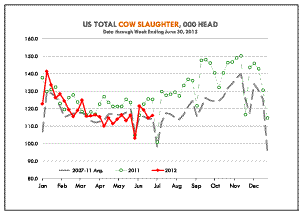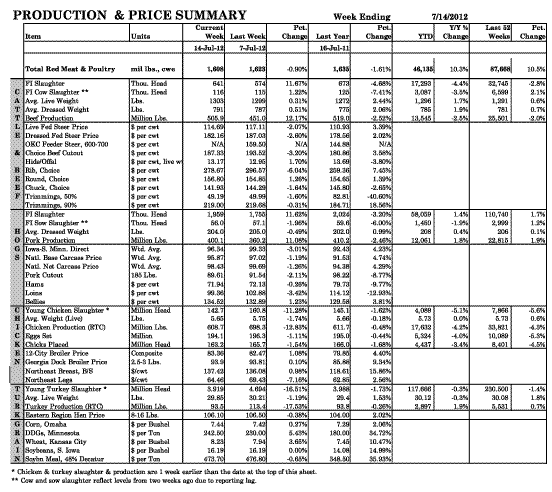Cows Heading to Slaughter
Total cattle slaughter for the week ending July 13 was 641,000 head, almost 12% higher than the previous week (holiday week) but still about 4.7% lower than a year ago. Lower fed-cattle slaughter has offset an increase in cow numbers.As pastures across much of the central United States continue to dry up, more cows are starting to show up. The official USDA data on cow slaughter is reported with a two-week lag, and it continues to show cow slaughter below year-ago levels (see chart). However, estimated cow slaughter for the week ending July 14 is about 3% higher than a year ago.
USDA last week reported that half of all U.S. pastures are in poor or very poor condition. While the situation in Texas and Oklahoma is a bit better than it was last year, it is still far from ideal. Missouri ratings show 86% of pastures there in poor or very poor condition.
Generally pasture conditions deteriorate throughout the summer, and the outlook so far is for current drought conditions to persist. This will continue to pressure cow-calf operators and push more cows to market.
Even more important for cow-calf operators, however, is the outlook for calf prices next year. Data show that feeder-cattle prices have a more pronounced impact on cow slaughter than pasture conditions. Feeder-cattle futures have dropped almost $20 per hundredweight (cwt.) in the last four weeks as corn, distillers' dried grains (DDG) and soybean meal values have skyrocketed.
Current corn cash price (Omaha basis) is near $7.5 per bushel (bu.), soybean meal is up 36% from last year at $474 per ton and DDGs are also up 35% (see table). Hay prices continue to also hit new highs with the national alfalfa price in June up 12% compared to last year.
There is a wide range of prices for hay, with high-quality alfalfa fetching more than $300 per ton in some areas. Some areas, like Missouri, are seeing farmers feeding hay to remaining livestock while feedlots are struggling with least-cost formulations given the simultaneous rise in just about all feedstock.
Editor's Note: This article is reprinted with permission from "The Daily Livestock Report," which is published by Steve Meyer and Len Steiner. To subscribe, visit www.dailylivestockreport.com.
Click on chart to see larger image.













